

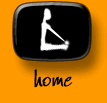 |
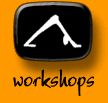 |
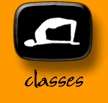 |
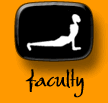 |
 |
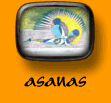 |
|
DOWNDOG | EAGLE | COBRA | HERO | HALF MOON | CORPSE | GATE
TRIANGLE | PEACOCK | LOCUST | COBBLER | SHOULDER STAND HEADSTAND | BRIDGE | CAMEL | COW FACE | UP BOW | INVERTED STAFF SEATED WIDE ANGLE | HEAD TO KNEE | TORTOISE | DANCER NOOSE  |
| Salabhasana ~ Locust Pose When you look at a locust or grasshopper, one of the first things you
see is a set of steely back legs raised diagonally and ready to launch
the insect into space with a powerful spring. In locust pose, you'll need
the same kind of power in your back and legs to lift into this energizing
asana. Images by Nancy Van Kanegan There are two main versions of salabhasana, and several variations of each, so don't be surprised if people do or teach this pose differently. All versions share the strong lift in the legs, require a lot of work in the back, and open the front of the body, so the benefits are similar. We'll look first at the version where the pelvis stays on the floor and both the upper body and legs are lifted. Then we'll look at the more advanced version, where the chin, upper body and arms are kept on the floor and the legs and pelvis are lifted. For first version, lie prone, resting on your chin with your hands palms up (or palms facing the thighs) along your sides, with the legs together. Energize the legs by drawing muscle energy to the bones and gently pulling it up from the toes into the center of the pelvis, then extending the bones back. Hug the legs together and root your tailbone down with a slight pelvic tuck. Energize the arms by drawing the muscle energy in and up and stretching the bones back through. Roll the shoulders up and back as you slide the shoulder blades down and in. With an inhale, stretch from your inner body out through the head, feet and arms as you lift them up, using your back muscles to arch up. Keep the neck level, the legs strong and gently squeezing together, and your tailbone in. After 4-5 breaths, lower with an exhale. You can rest with your forehead on stacked hands, with your toes out and heels in (downward facing corpse pose), or on one side of your face with the hands palms up along the thighs and the toes in, heels out. Repeat the pose once or twice more, perhaps trying one of the following variations. There are many variations of this version. For example, in the Ashtanga second series, salabhasana A is done with the hands kept on the floor, palms up, as you lift up. For salabhasana B, slide the hands forward, palms down, until the forearms are 90 degrees to the floor. In other variations you interlace your fingers behind your back and stretch back through the knuckles as you lift, or hold the opposite elbows behind the back and pull them back and up as you lift the head, chest and legs. Or you can extend the arms forward and lift them as you lift the legs and stretch them back. Also, notice the difference between lifting on an inhale and lifting on an exhale, letting your inner body expand as you exhale. Experiment with different variations and notice how they change the pose, and pick the ones you like best. If your back felt fine doing the version with the pelvis on the floor, you might try the one in which you lift the pelvis and legs up while you keep the head, arms and chest down (viparita salabhasana). Because this version creates pressure in the heart, head and lungs and brings a lot of blood to the throat and brain, it isn't recommended for people with heart conditions or high blood pressure. So just do the first version, or go very easy with this one, just lifting one leg at a time or keeping the pelvis on the floor and simply stretching back. Start by lying prone as before, but with your arms underneath your body, your hands in fists against your thighs, with the back of the hands on the floor. (Alternatively, you can put the back of the fists against your thighs, or have the fists thumb-side down along the thighs). Energize the legs and arms as in the previous version, legs together. Ease into the pose by first stretching and lifting one leg, raising it on the inhale higher and higher for 3-4 breaths, then lowering it and doing the same with the other. Then, with an inhale, press the arms into the floor and lift both legs up, trying to also lift the pelvis as the legs stretch back and squeeze together. Hold for 1-3 breaths, then release. If you didn't get very high, don't worry - that's normal. This version of salabhasana requires tremendous back strength and lots of flexibility in the torso. So if you even got the pelvis up a little bit, congratulate yourself and try it again after a rest. If you want more work on the arms, place the palms flat on the floor with the arms close together underneath the pelvis and thighs before you lift up. Whichever version you do, you'll find salabhasana a real upper. Just take it easy, letting your breath return to normal between repetitions. When you're finished, bring your hands under your shoulders and slowly and carefully lift up to your hands and knees, then fold back into child's pose, sitting bones on your heels, forehead on stacked hands or the floor. Breathe softly and glow happily, reflecting on the lessons you've learned from the locust. Text by Tim
Noworyta |
||
|
E-mail: info@yogamind.com | Return Home :: mindfully designed by braddon.com :: |